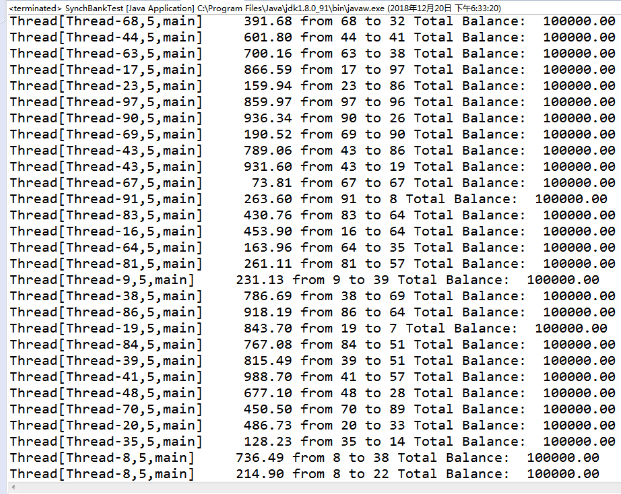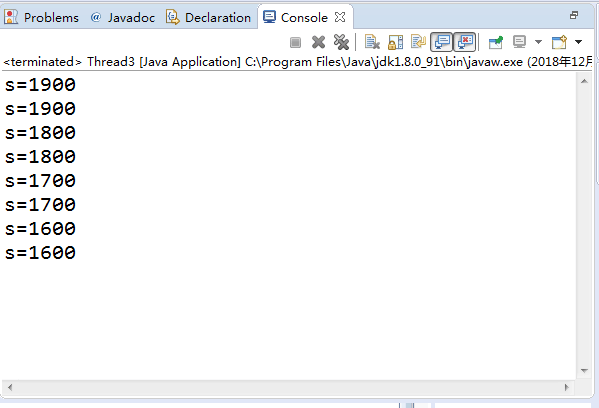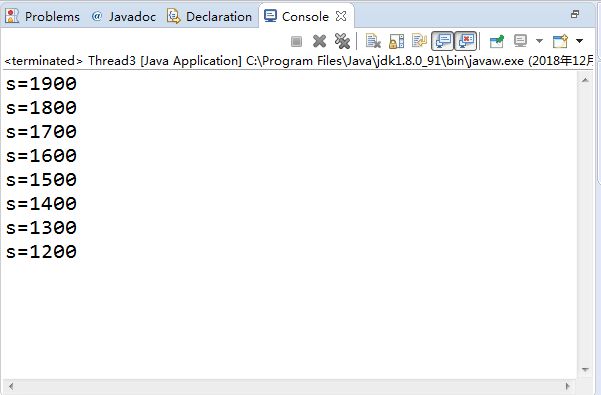201771010109焦旭超《面向物件程式設計(java)》第十七週學習總結
1、實驗目的與要求
(1) 掌握執行緒同步的概念及實現技術;
(2) 執行緒綜合程式設計練習
2、實驗內容和步驟
實驗1:測試程式並進行程式碼註釋。
測試程式1:
l 在Elipse環境下除錯教材651頁程式14-7,結合程式執行結果理解程式;
l 掌握利用鎖物件和條件物件實現的多執行緒同步技術。
程式碼:
package synch; import java.util.*; import java.util.concurrent.locks.*; /** * A bank with a number of bank accounts that uses locks for serializing access. *@version 1.30 2004-08-01 * @author Cay Horstmann */ public class Bank { private final double[] accounts;//銀行運轉的基本資料 private Lock bankLock;//鎖物件 private Condition sufficientFunds;// /** * Constructs the bank. * @param n the number of accounts * @param initialBalance the initial balance for each account*/ public Bank(int n, double initialBalance) { accounts = new double[n]; Arrays.fill(accounts, initialBalance); bankLock = new ReentrantLock(); sufficientFunds = bankLock.newCondition(); } /** * Transfers money from one account to another. * @param from the account to transfer from *@param to the account to transfer to * @param amount the amount to transfer */ public void transfer(int from, int to, double amount) throws InterruptedException { bankLock.lock(); try {//鎖物件的引用條件物件 while (accounts[from] < amount) sufficientFunds.await(); System.out.print(Thread.currentThread());//打印出執行緒號 accounts[from] -= amount; System.out.printf(" %10.2f from %d to %d", amount, from, to); accounts[to] += amount; System.out.printf(" Total Balance: %10.2f%n", getTotalBalance()); sufficientFunds.signal(); } finally { bankLock.unlock(); } } /** * Gets the sum of all account balances. * @return the total balance */ public double getTotalBalance() { bankLock.lock();//加鎖 try { double sum = 0; for (double a : accounts) sum += a; return sum; } finally { bankLock.unlock();//解鎖 } } /** * Gets the number of accounts in the bank. * @return the number of accounts */ public int size() { return accounts.length; } }
package synch; /** * This program shows how multiple threads can safely access a data structure. * @version 1.31 2015-06-21 * @author Cay Horstmann */ public class SynchBankTest { public static final int NACCOUNTS = 100; public static final double INITIAL_BALANCE = 1000; public static final double MAX_AMOUNT = 1000; public static final int DELAY = 10; public static void main(String[] args) { Bank bank = new Bank(NACCOUNTS, INITIAL_BALANCE); for (int i = 0; i < NACCOUNTS; i++) { int fromAccount = i; Runnable r = () -> { try { while (true) { int toAccount = (int) (bank.size() * Math.random()); double amount = MAX_AMOUNT * Math.random(); bank.transfer(fromAccount, toAccount, amount); Thread.sleep((int) (DELAY * Math.random())); } } catch (InterruptedException e) { } }; Thread t = new Thread(r); t.start(); } } }

測試程式2:
l 在Elipse環境下除錯教材655頁程式14-8,結合程式執行結果理解程式;
l 掌握synchronized在多執行緒同步中的應用。
程式碼:
package synch2; import java.util.*; /** * A bank with a number of bank accounts that uses synchronization primitives. * @version 1.30 2004-08-01 * @author Cay Horstmann */ public class Bank { private final double[] accounts; /** * Constructs the bank. * @param n the number of accounts * @param initialBalance the initial balance for each account */ public Bank(int n, double initialBalance) { accounts = new double[n]; Arrays.fill(accounts, initialBalance); } /** * Transfers money from one account to another. * @param from the account to transfer from * @param to the account to transfer to * @param amount the amount to transfer */ public synchronized void transfer(int from, int to, double amount) throws InterruptedException { while (accounts[from] < amount) wait();//導致執行緒進入等待狀態直到它被通知。該方法只能在一個同步方法中呼叫。 System.out.print(Thread.currentThread());//打印出執行緒號 accounts[from] -= amount; System.out.printf(" %10.2f from %d to %d", amount, from, to);//第一個列印結果保留兩位小數(最大範圍是十位), accounts[to] += amount; System.out.printf(" Total Balance: %10.2f%n", getTotalBalance()); notifyAll();//解除那些在該物件上呼叫wait方法的執行緒阻塞狀態。該方法只能在同步方法或同步塊內部呼叫。 } /** * Gets the sum of all account balances. * @return the total balance */ public synchronized double getTotalBalance() { double sum = 0; for (double a : accounts) sum += a; return sum; } /** * Gets the number of accounts in the bank. * @return the number of accounts */ public int size() { return accounts.length; } }
package synch2; /** * This program shows how multiple threads can safely access a data structure, * using synchronized methods. * @version 1.31 2015-06-21 * @author Cay Horstmann */ public class SynchBankTest2 { public static final int NACCOUNTS = 100; public static final double INITIAL_BALANCE = 1000; public static final double MAX_AMOUNT = 1000; public static final int DELAY = 10; public static void main(String[] args) { Bank bank = new Bank(NACCOUNTS, INITIAL_BALANCE); for (int i = 0; i < NACCOUNTS; i++) { int fromAccount = i; Runnable r = () -> { try { while (true) { int toAccount = (int) (bank.size() * Math.random()); double amount = MAX_AMOUNT * Math.random(); bank.transfer(fromAccount, toAccount, amount); Thread.sleep((int) (DELAY * Math.random())); } } catch (InterruptedException e) { } }; Thread t = new Thread(r); t.start(); } } }

測試程式3:
l 在Elipse環境下執行以下程式,結合程式執行結果分析程式存在問題;
l 嘗試解決程式中存在問題。
| class Cbank { private static int s=2000; public static void sub(int m) { int temp=s; temp=temp-m; try { Thread.sleep((int)(1000*Math.random())); } catch (InterruptedException e) { } s=temp; System.out.println("s="+s); } }
class Customer extends Thread { public void run() { for( int i=1; i<=4; i++) Cbank.sub(100); } } public class Thread3 { public static void main(String args[]) { Customer customer1 = new Customer(); Customer customer2 = new Customer(); customer1.start(); customer2.start(); } } |

修改後
class Cbank { private static int s=2000; public synchronized static void sub(int m) { int temp=s; temp=temp-m; try { Thread.sleep((int)(1000*Math.random())); } catch (InterruptedException e) { } s=temp; System.out.println("s="+s); } } class Customer extends Thread { public void run() { for( int i=1; i<=4; i++) Cbank.sub(100); } } public class Thread3 { public static void main(String args[]) { Customer customer1 = new Customer(); Customer customer2 = new Customer(); customer1.start(); customer2.start(); } }

實驗2 程式設計練習
利用多執行緒及同步方法,編寫一個程式模擬火車票售票系統,共3個視窗,賣10張票,程式輸出結果類似(程式輸出不唯一,可以是其他類似結果)。
Thread-0視窗售:第1張票
Thread-0視窗售:第2張票
Thread-1視窗售:第3張票
Thread-2視窗售:第4張票
Thread-2視窗售:第5張票
Thread-1視窗售:第6張票
Thread-0視窗售:第7張票
Thread-2視窗售:第8張票
Thread-1視窗售:第9張票
Thread-0視窗售:第10張票
程式碼:
package xaincheng; import java.nio.charset.MalformedInputException; public class Demo { public static void main(String[] args) { Mythread mythread= new Mythread(); Thread t1 = new Thread(mythread); Thread t2 = new Thread(mythread); Thread t3 = new Thread(mythread); t1.start(); t2.start(); t3.start(); } } class Mythread implements Runnable{ int t=1; boolean flag=true; public void run() { while(flag) { try { Thread.sleep(500); } catch (InterruptedException e) { e.printStackTrace(); } synchronized (this) { if(t<=10){ System.out.println(Thread.currentThread().getName()+"視窗售:第"+t+"張票"); t++; } if(t>10){ flag=false; } } } } }

實驗總結:
這周學習的多執行緒處理技術,相對於前幾周實驗來說很簡單,但是實驗本來就是這樣,是一個有難到易的過程.等把很多難的東西學過之後再回頭髮現,這些都很容易.
